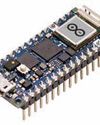Denemek ALTIN - Özgür
An Introduction to Inodes
Open Source For You
|May 2025
Understanding inodes can be invaluable for troubleshooting disk-space issues, optimising filesystem performance, and recovering deleted files.
-

An inode (short for 'index node') is the link between a file name and its physical location on a storage device. In the UNIX and Linux operating systems, inodes are data structures used to hold metadata about files and directories. A filesystem is how an operating system organises and stores files on a storage device. Each filesystem on the computer has its own separate set of inodes. In short, each filesystem mounted on a computer has its inodes, which are stored in a common table. An inode number can be used more than once but not by the same filesystem. The filesystem ID is paired with the inode number to create a unique identification label.
When a filesystem is created, a fixed number of inodes is created. Typically, approximately 1% of the filesystem disk space is allocated to the inode table. Each file and directory in a filesystem is assigned a unique inode, which is identifiable by an integer known as the inode number. A filesystem is typically separated into inodes and data blocks.
The directory is implemented as a table that maps the filenames to inode numbers. Every file in a directory table is an entry with a filename and inode numbers. All other information about the file is obtained by referencing the inode number in the inode table. When a file is opened, the operating system uses the inode’s pointers to navigate through the disk and retrieve the file content from its physical location. This process is seamless for users but relies heavily on these ‘directions’ stored in the inodes.
File size: This is the size of the file in bytes.
Ownership: The file owner and the group are determined by their user ID (UID) and group ID (GID).
Permissions: Read, write, and execute permissions for the file define access control.
Timestamps: Inodes record timestamps that provide modification (mtime), last access (atime), and inode change times (ctime).
Bu hikaye Open Source For You dergisinin May 2025 baskısından alınmıştır.
Binlerce özenle seçilmiş premium hikayeye ve 9.000'den fazla dergi ve gazeteye erişmek için Magzter GOLD'a abone olun.
Zaten abone misiniz? Oturum aç
Open Source For You'den DAHA FAZLA HİKAYE

Open Source For You
The Role of Open Source in Building Modern Data Infrastructure
It's no secret that open source is emerging as the backbone of modern data infrastructure. Here’s a list of the core open source technologies used to deploy this infrastructure, along with some real-world examples and a brief on why open source matters.
3 mins
December 2025

Open Source For You
The Whispering Machines: How Open Source is Bringing Intelligence to the Tiniest Devices
Built on open source frameworks, TinyML is enabling complex machine learning models to run on the microcontrollers embedded in connected devices, bringing artificial intelligence to the very edge of the network.
3 mins
December 2025

Open Source For You
Setting Up Snort to Secure Your Network
Snort is a popular, open source intrusion detection system that monitors traffic in real time to detect malware. Here’s a detailed explanation of how to set it up on Ubuntu and test it by generating traffic from another system.
7 mins
December 2025

Open Source For You
When AI Meets DevOps to Build Self-Healing Systems
Traditional DevOps, with its rule-based automation, is struggling to work effectively in today’s complex tech world. But when combined with AlOps, it can lead to IT systems that predict failures and solve issues without human intervention.
7 mins
December 2025

Open Source For You
How to Automate Java Code Modernisation
This short guide illustrates that automating Java code modernisation with Python and OpenAI API is not just possible-it's remarkably effective.
5 mins
December 2025

Open Source For You
The Quest to Build a Quantum Computer
The road to large-scale quantum computing is long and hard, with incremental advances paving the way. But the destination is in sight.
12 mins
December 2025

Open Source For You
Job Opportunities: What's Hot in the Cloud Space?
If there's one field that refuses to slow down, it's cloud computing. Even as automation and AI reshape roles, cloud adoption continues to surge. From startups deploying microservices overnight to enterprises migrating decades of legacy systems, cloud remains the engine of digital transformation. For professionals, this means one thing: skills that live in the cloud won't come down anytime soon.
2 mins
December 2025

Open Source For You
Securing Client Identity with Post-Quantum Cryptography
Here's a quick tutorial on how to build a secure, real world client-server model that establishes client identity by using CRYSTALS-Dilithium, a post-quantum cryptography algorithm.
3 mins
December 2025

Open Source For You
Unlocking the Power of Multi-Agent Solutions with the Microsoft Agentic Framework
The Microsoft Agentic Framework is rapidly emerging as a cornerstone for developers, architects, and technology leaders seeking to build dynamic, intelligent systems powered by multiple collaborating agents. In an era where automation, distributed intelligence, and adaptive software are increasingly vital, this framework offers robust tools and features to accelerate the design and deployment of agent-based solutions.
6 mins
December 2025

Open Source For You
Apache Iceberg and Trino: Powering Data Lakehouse Architecture
Apache Iceberg is a cornerstone of any open data lakehouse, providing the transactional foundation upon which highly scalable and flexible analytics can flourish. Along with Trino, it can be used to build a robust, scalable, and high-performance data lakehouse.
4 mins
December 2025
Listen
Translate
Change font size
